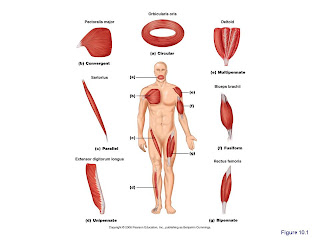Interactions of Skeletal Muscles in the Body
- Muscles only pull; they are not capable of pushing.
The muscle that provides the major force for the specific movement is called the prime mover or the agonist.
Muscles that oppose or reverse a particular movement are called the antagonists.
Synergists help the prime movers by adding extra force to the same movement, or by reducing undesirable or unnecessary movements.
Naming Skeletal Muscles )
- Bone or body region with which the muscle is associated.
- Shape
- Relative size (maximus, minimus, longus, and brevis)
- Direction in which fibers run in relation to an imaginary line of the body, such as the midline.
- Number of origins (biceps, triceps, or quadriceps)
- Location of origin and insertion.
- Action (flexor or extensor)
Muscle Mechanics: Importance of Fascicle Arrangement and Leverage
In skeletal muscles the common arrangement of the fascicles varies, resulting in muscles with different shapes and functional capabilities.1)
- Circular - fascicles are arranged in concentric rings
- Convergent - a broad origin and fascicles converge toward a single tendon of insertion
- Parallel - the long axis of the fascicles runs parallel to the long axis of the muscle
- Fusiform - a spindle-shaped parallel arrangement of fascicles
- Pennate - fascicles are short and attach obliquely to a central tendon that runs the length of the muscle
- The operation of most skeletal muscles involves the use of leverage and lever systems, partnerships between the muscular and skeletal systems.A lever is a rigid bar that moves on a fixed point, or a fulcrum, when a force is applied to it.The applied force, or effort is used to move a resistance or load.The distance between the point force (effort) is applied and the fulcrum is the effort arm.The distance between the load and the fulcrum is the load arm.The way levers work is a lot like the way a see-saw works - if two people sit on a see-saw at the exact same distance from the center point (the fulcrum) they will balance if they weigh the same. If one person is heavier the see-saw can still be balanced, the heavier person just has to move closer to the fulcrum.That can be expressed this way: [weight of person #1] X [distance person #1 is from center point (fulcrum)] = [weight of person #2] X [distance person #2 is from center point (fulcrum)]If person #1 is really heavy (a load) and person #2 wants to move them up in the air it can be done with little effort by adjusting the distance between the load and the center point, or fulcrum (the load arm) and the distance between the place effort will be exerted and the fulcrum (the effort arm).Since [load] X [length of load arm] = [effort] X [length of effort arm] you could move almost any load with little effort just by making the load arm short and the effort arm long.That's why Archimedes, the Greek mathematician, physicist, and engineer said "Give me a lever long enough and a fulcrum on which to place it, and I shall move the world.”We use levers everyday for a number of purposes besides moving bones. Some levers allow us to move great loads with little effort, while others require more effort but allow us to move loads very quickly over longer distances.Power levers operate at a mechanical advantage:- The effort arm is longer than the load arm, so it takes less force to move a heavier load- Speed and range of motion are sacrificedSpeed levers operate at a mechanical disadvantage:- The effort arm is shorter than the load arm, so it takes more force to move a lighter load- Speed and range of motion are increased

